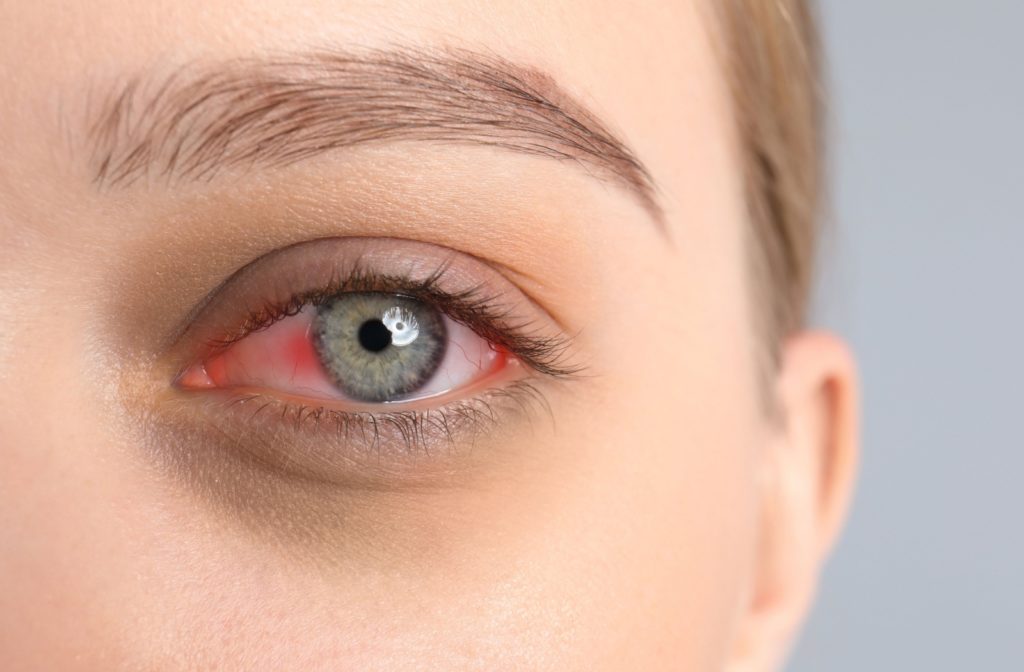Have you noticed pesky little shadows or specks drifting across your field of vision? Or do you frequently struggle with dry, irritated eyes? If you’re dealing with either—or both—you might wonder if there’s a connection between dry eyes and floaters.
Dry eyes and floaters are two common eye conditions, but they’re unrelated. While many people notice them occurring together, dry eyes don’t actually cause floaters.
Your eye doctor can assess your vision with a comprehensive eye exam and determine the underlying cause of your symptoms. With proper treatment, you can find relief from dry eyes and vision discomfort.
What Is Dry Eye?
Dry eye occurs when tears fail to provide adequate lubrication for your eyes. This may be due to insufficient tear production, poor-quality tears, or excessive screen time.
Causes of dry eyes include:
- Aging (especially individuals over 50)
- Hormonal changes, particularly in women during menopause
- Medications like antihistamines or antidepressants
- Environmental factors, such as wind or dry climates
Symptoms of dry eyes include:
- Irritation
- Stinging or burning sensation
- Redness
- Light sensitivity
- A feeling of having something in your eye
- Blurry vision
Dry Eye Diagnosis & Treatment
Your eye doctor will evaluate your medical history, perform a comprehensive eye exam, and possibly conduct specialized tests to measure the quantity and quality of your tears to diagnose dry eye. Dry eye treatment is based on the underlying cause and can include the following:
- Artificial tears or lubricating eye drops
- Warm compresses and heated masks
- Reducing screen time and taking regular breaks
- Prescription medications
- Eye inserts or punctal plugs to improve tear production
What Are Floaters?
Floaters are small, shadowy shapes or threads that float in your vision. They’re most noticeable when looking at a bright, plain background—like a clear blue sky or a white computer screen. Floaters are caused when tiny bits of the gel-like fluid vitreous in your eye clump together, casting shadows on your retina (the light-sensitive tissue at the back of the eye).
Causes of floaters include:
- Age-related changes in the vitreous gel of the eye
- Eye infections or inflammation
- Eye injuries
- Retinal detachment or tears
Floaters can appear as:
- Small shapes drifting across your field of vision
- Thread-like lines or squiggly shapes
- Cloudy or shadowy spots
- Cobwebs
- Shapes that move as your eyes move
While floaters are usually harmless, a sudden large increase in floaters or the development of new floaters could indicate a serious problem that requires immediate medical attention.
Floaters: Diagnosis & Treatment
Floaters are typically diagnosed through a dilated eye exam, where your eye doctor examines the retina to rule out serious issues like retinal detachment.
Most floaters don’t require treatment. However, for severe cases that impair vision, your eye doctor may consider surgical options such as a vitrectomy or laser therapy.
Can Dry Eye Cause Floaters?
Dry eyes don’t cause floaters. However, both dry eyes and floaters commonly occur with aging. Tear production decreases as we grow older, leading to dry eyes, and the vitreous humor in the eye shrinks, which contributes to floaters.
How Dry Eyes & Floaters Impact Vision
Both conditions can diminish your quality of vision and overall visual comfort. Dry eyes may cause blurriness and strain, while floaters interfere with a clear line of sight. Separately, these issues are manageable—but together, they can make everyday activities like reading or driving uncomfortable.
Sometimes, dry eyes might intensify your perception of floaters due to increased eye sensitivity. For instance, poor tear quality could result in dry eyes, the symptoms of which make the shadows caused by floaters more visible. Similarly, blurry or uncomfortable vision may amplify floaters’ visibility. While neither condition directly worsens the other, effective management is still essential for maintaining good vision.
How to Prevent Dry Eyes & Floaters
While it’s impossible to prevent all instances of dry eyes and floaters, certain lifestyle adjustments can minimize your risk and improve overall eye health.
Tips for preventing dry eyes include:
- Keep your eyes hydrated with regular use of artificial tears.
- Stay hydrated—drink plenty of water throughout the day.
- Use a humidifier if you’re in a dry or air-conditioned environment.
- Follow the 20-20-20 rule during screen use (look at something 20 feet away for 20 seconds every 20 minutes).
Tips for preventing floaters include:
- Protect your eyes from injuries by wearing safety goggles when necessary.
- Schedule regular eye exams to catch early warning signs of retinal issues.
- Maintain a healthy diet to support eye health.
- Be mindful of your overall health—conditions like diabetes can increase your risk of floaters.
A Path to Comfortable, Clear Vision
Dry eyes and floaters don’t have to disrupt your quality of life. While these conditions may coexist, understanding them and seeking professional care can help you tackle them effectively.
If you’re struggling with symptoms, book an appointment with 2020 Eyecare Ohio for personalized advice and treatment strategies to protect your vision and eye health.



